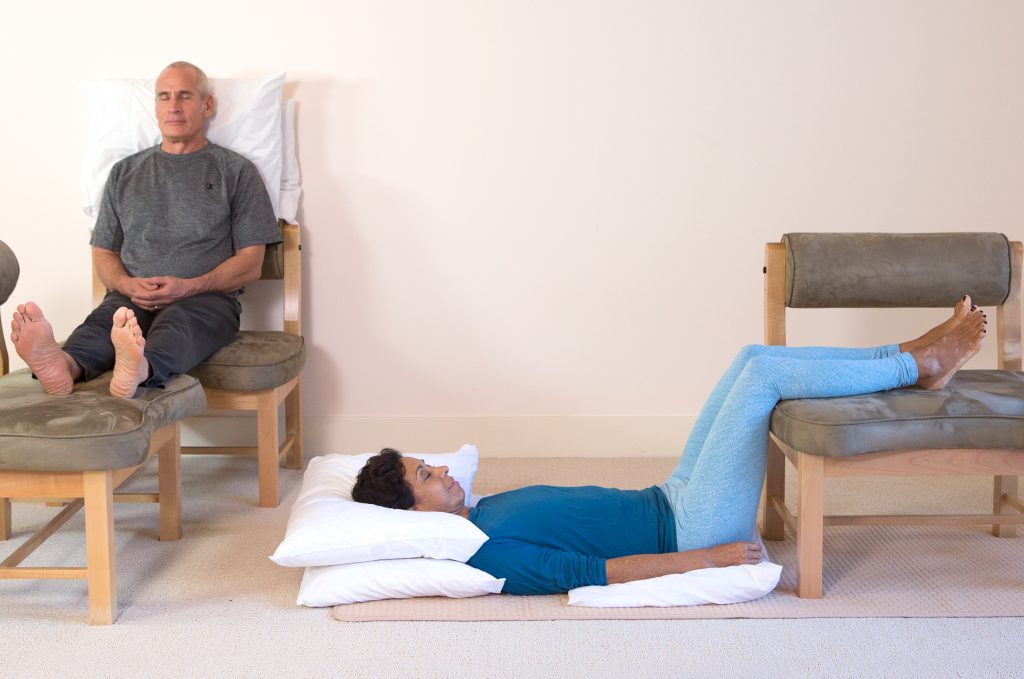
Finding Calm By Turning Upside Down
Sigh…..daily life is stressful. Whether it’s the mounting pressures of work, navigating family and relationships, or the chaos and turmoil we feel when we turn on the news, it all has an effect on our health and well-being.
Shoulder stand is a classic inversion that lets the nervous system and heart power down
Chronic stress takes its toll on the body by raising stress hormones like adrenaline and cortisol. Cortisol increases sugars (glucose) in the bloodstream while adrenaline increases your heart rate, elevates your blood pressure and boosts energy so you can prepare to fight or flee. These stress hormones interfere with the peaceful internal environment we need to cultivate for optimal health. For this reason, practicing some stress management will help to stay balanced and calm in the midst of everyday life.
The Queen of Yoga Postures
There are many techniques and practices from which to choose in order to calm down. Modified shoulder stand, however, is one of the most powerful as well as my personal favorite for restoring overall health and well-being. It’s a classic inversion that lets the nervous system and heart power down. It is considered the queen of yoga postures because of its overall impact on the body and mind.
How Shoulder Stand is Done and Why it’s Helpful
- Lying on the floor, place one bed pillow under the back of the pelvis.
- Then place both legs up on the seat of a chair. Try to support the calves up through the back of the knees.
- Now place a second bed pillow under the back of the head so the chin is slightly tucked downward.
- Let yourself relax and breathe.
- Stay this is position for 3-15 mins at a time.
The Effect of Shoulder Stand
When the legs are elevated, the blood from the legs starts to drain back towards the pelvis and lower back. This provides some venous return and reduces the load on the veins of the legs. It also pools the blood in the abdomen so that low back is bathed with a fresh supply of blood. Additionally, it releases the lumbar curve and takes the strain off the low back by releasing any tensions you may have stored there.
With the pillow under the buttocks, the pooling blood in the abdomen is then lifted towards the heart delivering additional blood flow to the heart and lungs. This blood is then carried to the neck. Since there is a pillow under the head, the chin is tucked down so there is a second pooling of blood in the area of the thyroid gland and the carotid arteries. The thyroid is the master gland responsible for controlling metabolism.
The carotid arteries are the receptors that tell the brain that the heart has enough blood and it doesn’t need to pump so hard. So, in turn the heart rate lowers and blood pressure lowers. While the initial inclination is for the blood pressure to rise when we are upside down, it may rise momentarily. In a few minutes, however, the heart rate lowers and the body adjusts to the mild inversion. The blood pressure also comes down therefore improving blood pressure variability as well.
The Key to the Most Benefit
The key is that the pillow lifts the buttocks, and the second pillow tucks the chin down so the blood pools in abdomen, and then the neck. This is why it is often referred to as the pose of two waterfalls. One waterfall of blood and energy extends from the legs to the abdomen and one from the abdomen to the neck.
Lying in this position also drains the lymph. The lymphatic system is not a pumped system so there is additional support given to it when we rest the legs up on the chair. The brain and the spinal cord form the control center known as the central nervous system. The cervical (neck) nerves control sensations in the body and breathing. When the neck is tucked down it sends a message through those nerves to rest the nervous system.
Taking time to rest in this deeply restorative mild inversion posture provides maximum benefits in managing the ups and downs of our ordinary lives. It teaches us how to remain calm when everything is turned upside down. Try it and see. Your body may just thank you for the help.
Consider Seated Chair Version For These Conditions
You may want to consult your doctor about this alternate shoulder stand if you have any of the following: Menstruation, GERD (Reflux), and Hiatal Hernia, Significant cervical/spinal arthritis, Labile Hypertension, Vagal Syncope, Significant Carotid Stenosis, History of Stroke, Retinopathy, Retinal Hemorrhage, Detached Retina, Glaucoma.








